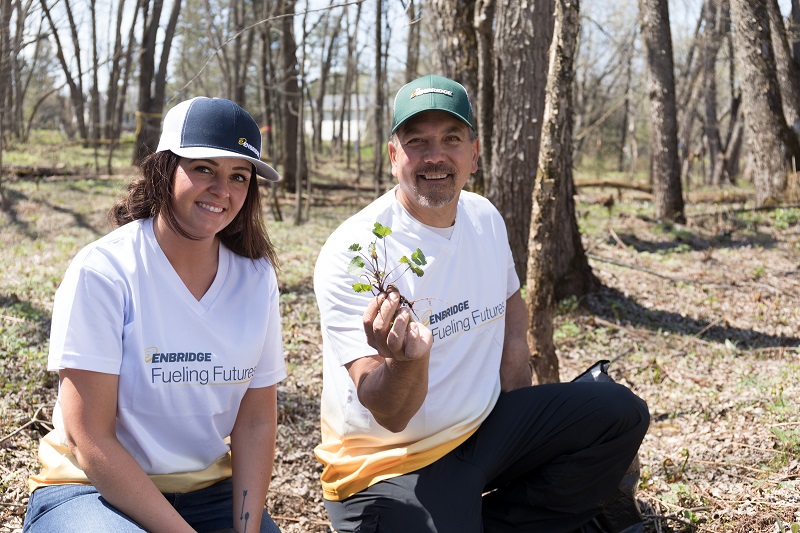Garlic mustard: Good for you, bad for plants
 Picking garlic mustard in northern Wisconsin.
Picking garlic mustard in northern Wisconsin.
Enbridge volunteers tackle edible, invasive weed
May 26, 2022
“Crush a leaf in your hand and that’s exactly what it smells like, garlic mustard,” said volunteer Taylor Whitebird-Salo who was part of a group removing the weed by hand just outside of Mellen, Wisconsin.
Nutritionists say garlic mustard—a leafy green high in fiber, beta-carotene, omega-3 fatty acids and vitamin E—is good for you. However, it’s not good for native plants if left to spread unchecked in the environment.
“It produces lots of seeds, and also releases a toxin that can kill favorable fungi in the ground. So, we’re out here helping the community pick it and minimize the impact from this invasive species,” explained volunteer Adam Erickson.
About a dozen volunteers from Enbridge spread out over a sunny stretch of woods near Mellen, hand pulling garlic mustard plants with as much of the root as possible. Timing is everything. The weeds must be removed before the garlic mustard’s tiny white flowers can form and spread hundreds of seeds from each plant. Garlic mustard can be found in all four counties in northern Wisconsin.
“This is our second year helping to eradicate garlic mustard. It chokes out native plants. What we’re trying to do today is eliminate it here, so it doesn’t travel any further,” added Michelle Johnson, who helped coordinate the weed pulling event. “At Enbridge we like to support community initiatives and one of the important initiatives here is getting rid of garlic mustard.”
“I’m here because I love volunteering, and building relationships with communities,” added Taylor Whitebird-Salo. “It’s really important for Enbridge to be out in the community and to protect the environment.”
 Enbridge volunteers with garlic mustard in northern Wisconsin.
Enbridge volunteers with garlic mustard in northern Wisconsin.
Enbridge routinely supports community efforts like this one and encourages employees to pitch in. In 2021 through its Fueling Futures program Enbridge invested $334,900 in community-strengthening initiatives across Wisconsin—and supported numerous not-for-profit agencies in the state—aligned to three focus areas health and safety, environment, and community.
A community partner in Wisconsin for over 70 years
Enbridge’s workforce includes approximately 329 Wisconsin-based permanent and temporary employees, and provisioned contractors. In 2021 Enbridge’s capital, operating and administrative expenditures in Wisconsin totaled $304 million. That same year the company spent more than $35 million in taxes in the state.
Now Enbridge is seeking permits for a major project in northern Wisconsin. The Bad River Band of the Lake Superior Tribe of Chippewa filed suit in 2019 to remove an Enbridge pipeline, Line 5, from their reservation in northern Wisconsin. Enbridge is proposing to route a segment of the pipeline around the reservation.
A project labor agreement signed for the Line 5 re-route ensures the project will be built by a trained union workforce creating 700 family-supporting construction jobs and pumping millions in project related spending into local communities. An estimated $46 million will be spent with Native-owned businesses, as well as training and hiring Native American workers who will make up at least 10% of the project workforce.
Agreements have been reached with 100% of private landowners along the re-route, chosen because it minimizes environmental impacts and protects critical resources.
Enbridge says construction will move forward once all necessary permits are received.








